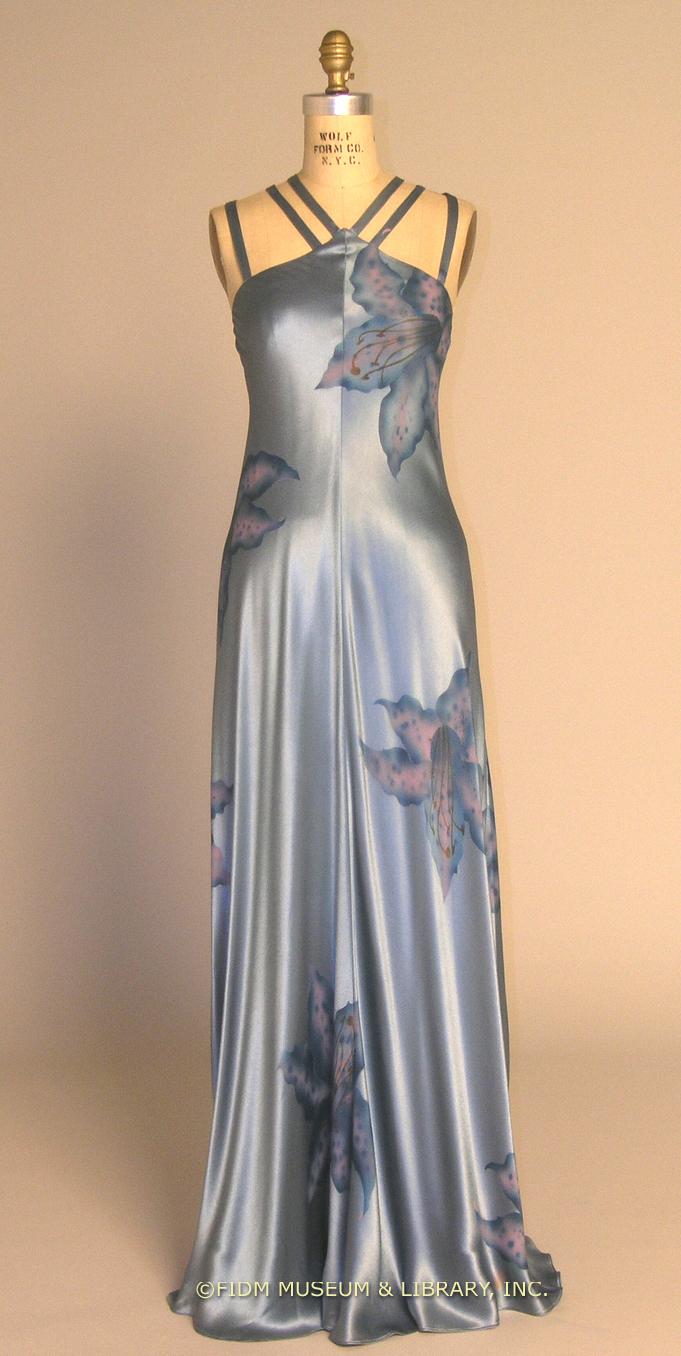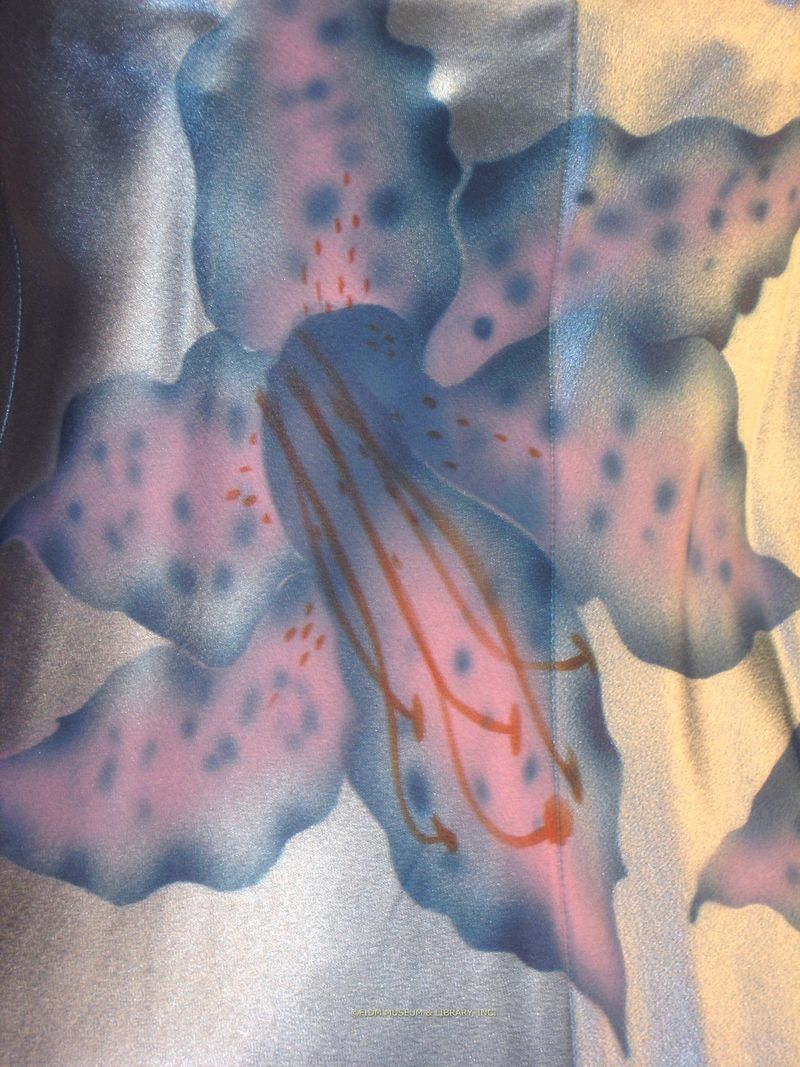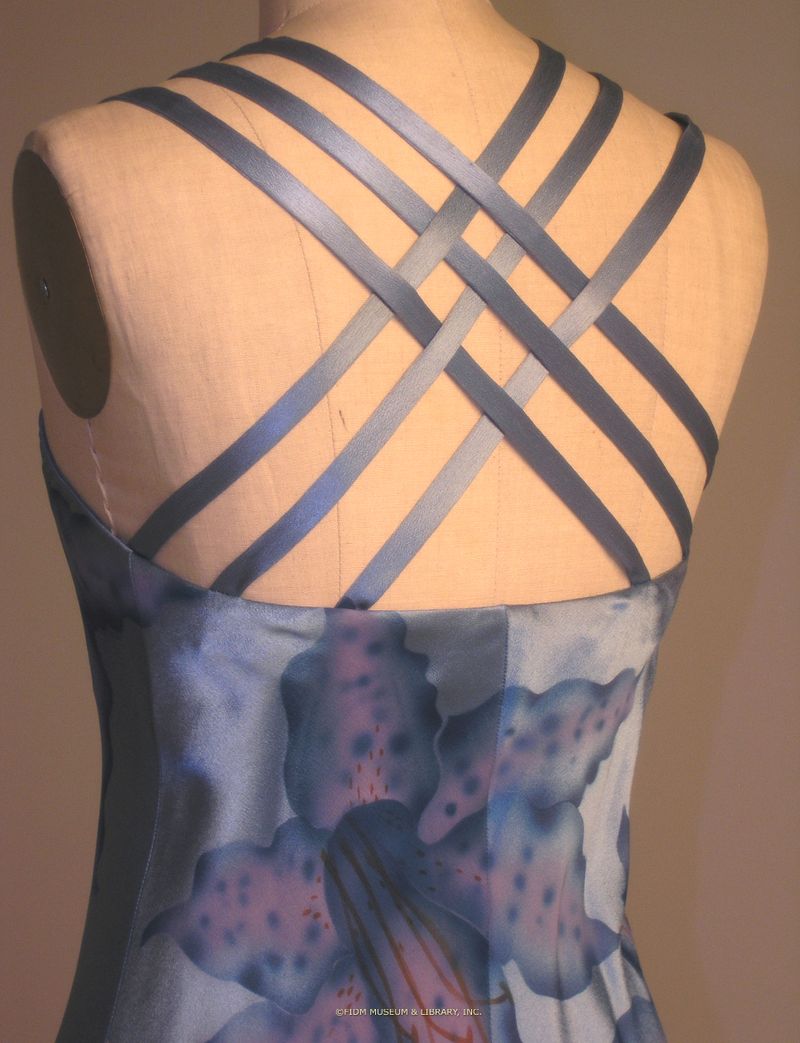Los Angeles-based designer Holly Harp (1939-1995) began her fashion career in the late 1960s, designing theatrical, psychedelic clothing for iconic performers such as Janis Joplin and Grace Slick of Jefferson Airplane. Harp’s early designs were in tune with the catch-all aesthetic of late 1960s hippie fashions, and her garments quickly gained a reputation for “being wild and wonderful, feathers and fringe.”1 A maxi-dress worn by the singer-songwriter Dory Previn was typical of Harp’s aesthetic. Constructed of an old table cloth, green doily and a piece of vintage satin, it was described as a “clothing mosaic.”2 In 1968, Harp opened Holly’s Harp, a small boutique on the Sunset Strip where she sold both her ready-made and custom-designed garments.
Within a few years, Harp’s designs had taken on a very different character. Instead of merely incorporating bits and pieces of the past by using vintage textiles, Harp started designing slinky, overtly sexy dresses and separates that referenced the glamour of Old Hollywood. Using silk textiles such as jersey, crepe and chiffon, Harp created what she called ” fantasy-oriented…mood clothes.”3 These mood clothes often referenced 1930s evening wear, as in the Holly’s Harp bias-cut dress seen here.
c. 1978
Gift of Gloria Strasburger
99.655.3
Harp often recruited local artists and craftspeople to hand-paint or airbrush designs on completed garments. These designs usually took the form of floral motifs, such as the iris (or lily?) seen in the FIDM Museum dress.
In interviews, Harp was always very open about the fact that she designed for a very specific segment of the population. She felt that her strength lay in designing “special clothes for special people,” many of whom were Hollywood stars such as Liza Minelli, Diana Ross, Ali McGraw and Sally Field.4 Harp was also very clear that she designed for a specific body type, stating that “you just can’t put lumpy bodies in my clothes.” 5 During print interviews, however, Harp regularly encouraged women to feel good about their specific body type. Harp’s somewhat contradictory views accurately pinpoint the tension between ideal and real that is always present in fashion.
Harp maintained her “sexy not solicitous” aesthetic throughout the 1970s and into the 1980s. Throughout this period, Holly’s Harp retailed both through the eponymous boutique and at major retailers on both the East and West coasts. Though her line remained popular, it moved further and further away from mainstream fashion, which emphasized a more masculine, power-oriented aesthetic for women. In 1986, Harp closed her boutique, though she continued to produce private commissions from her studio until her death in 1995.
1 Krier, Beth Ann. “Subtlety Newest Boutique Commodity.” Los Angeles Times 27 April 1972: 11.
2 Krier, Beth Ann. “Hiding a Naked Lady.” Los Angeles Times 6 June 1971: W20.
3 “No Lumpen Proletariat for Designer Holly Harp.” Los Angeles Times 4 Sept. 1975: G2.
4 Luther, Marylou. “Shuck Perfection, Slink Into Real.” Los Angeles Times 25 Jan. 1976: D1.
5 Ibid.






Oh wow; the straps on this dress are just awesome. I’ve done some similar criss-crossing in some gowns I’ve made in the past, but they didn’t look this cool!
One question though…I’m assuming the dress has a side zip on the side away from the camera? Or perhaps since it’s bias cut, the wearer could just wriggle into it?
What beautiful draping. Would love to know what the back of the gown looks like, especially since those straps are quite interesting.
Katrina, you are right in thinking that the wearer of this dress would “wriggle into it.” There are no fasteners or zippers at all!
Ingrid, take a look at the 3rd photo in this post, as that’s actually the back of the dress. Let me know if you are unable to view it.
I agree with both of you…the straps make this dress even more appealing!
Hey like this one also..I have one dress like this design. I wore it on my friend’s wedding last month. Nicely boutique management and I was looking really amazing praised by my husband..
Ah yes, the days before implants, when no support was needed in the first place. There used to be a teeny boutique in Costa Mesa called Rainbow Bridge in the early 70’s. They specialized in that sort of air brush on more mass market type knit tops. Beautiful piece here.
Holly was an amazing talent and person! I was lucky to be her first design assistant when I graduated from Parson’s!
She designed by her own rules! Holly was a rebel in fashion!
Bert, I bet you have a lot of stories about Holly! We’ll be posting on another of her dresses sometime in the next few weeks, so stay tuned to our blog.
Holly was my godmother and I had the sincere pleasure of using her design room as a playground when we visted her factory in culver city as kids. She passed away when I was around 11 but I can still recall her vibrant spirit and rebellious streak. Her clothes tended to carry a soft yet outspoken tone that truly reflected her personality.
Nice design, like it very much. Is it silk?
Hi Dmitriy, the dress is actually Rayon/Acetate, though it certainly has the appearance of silk!